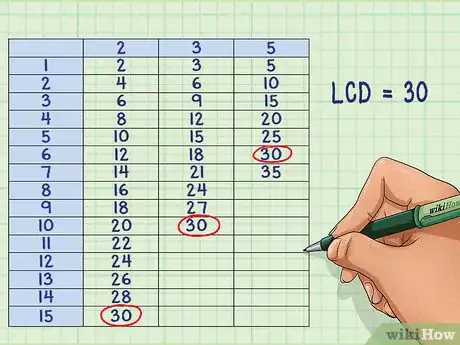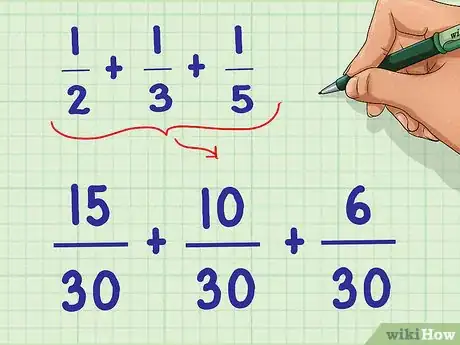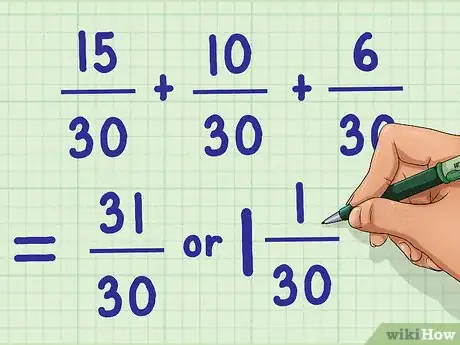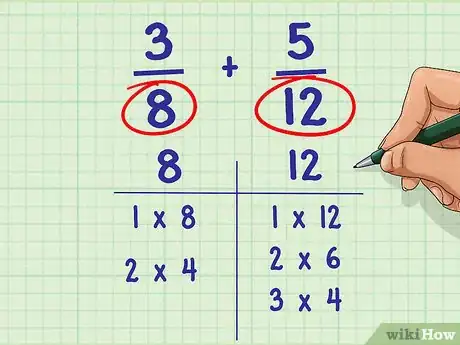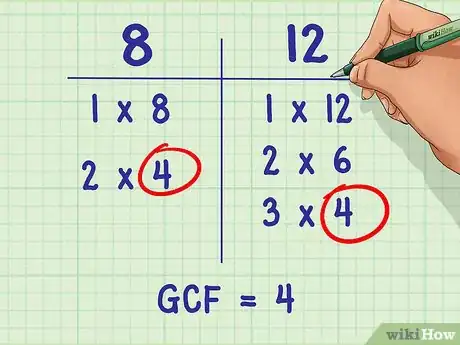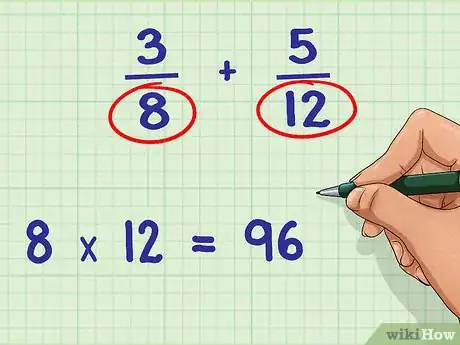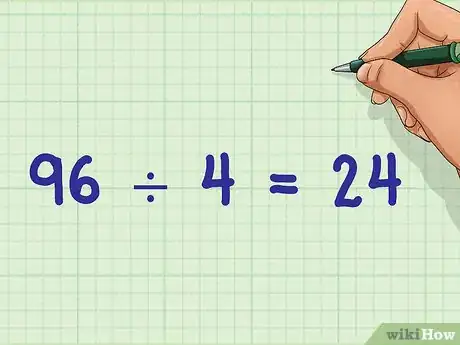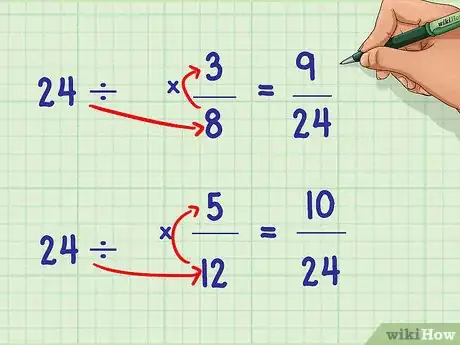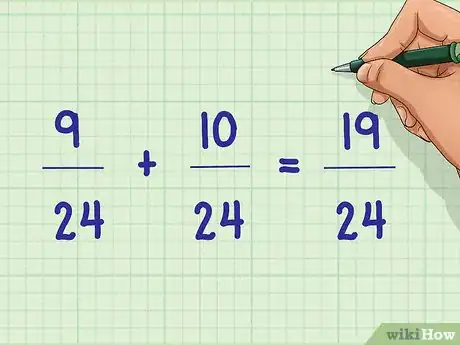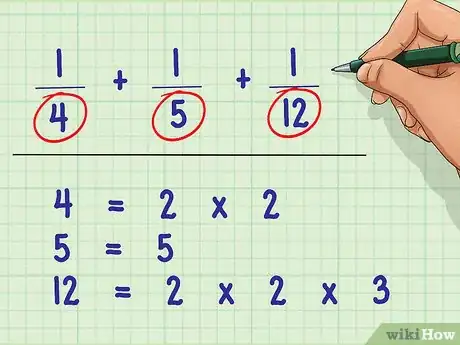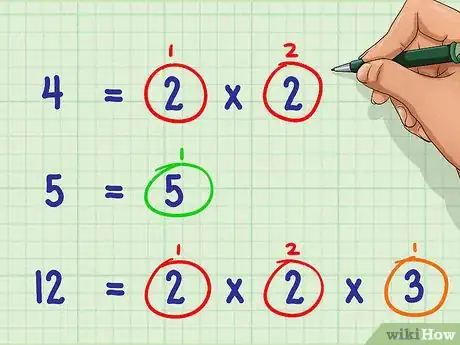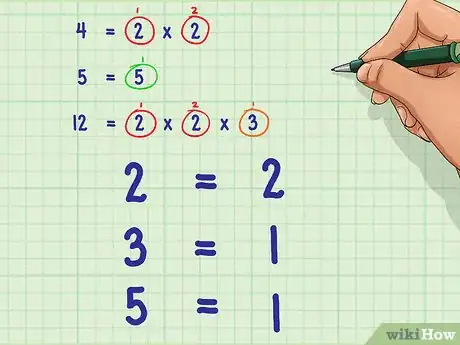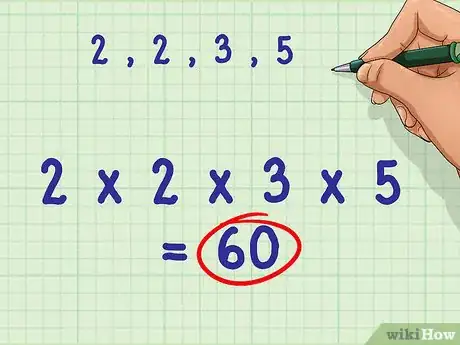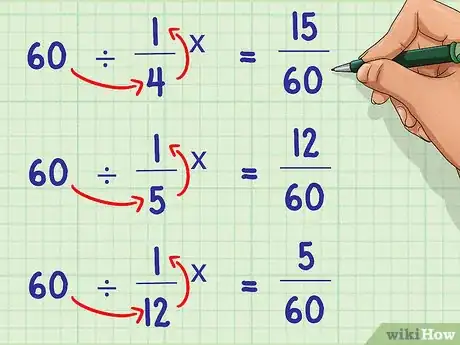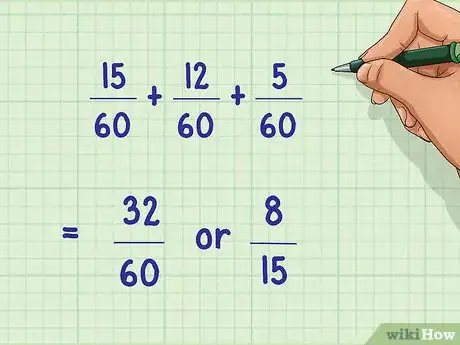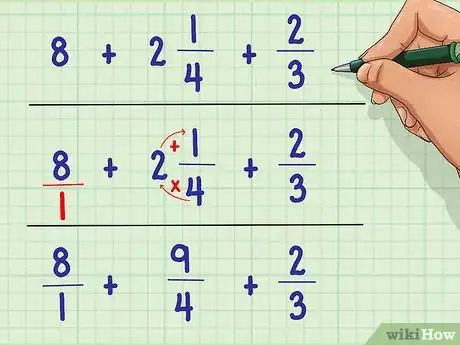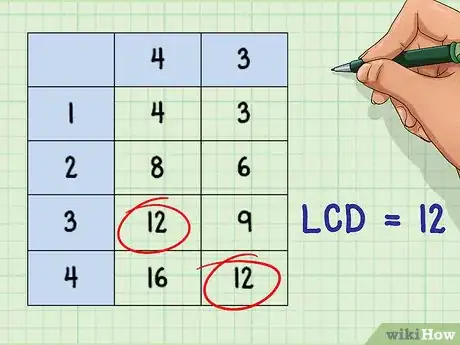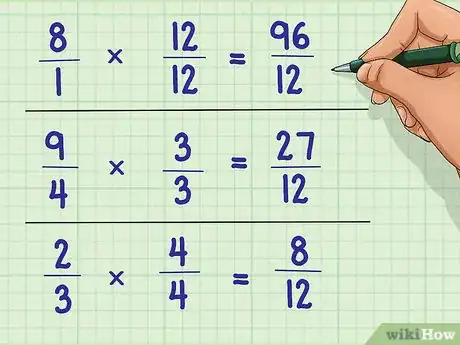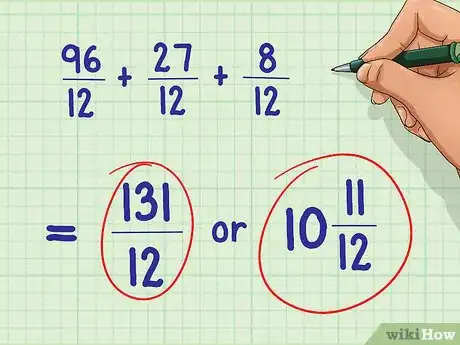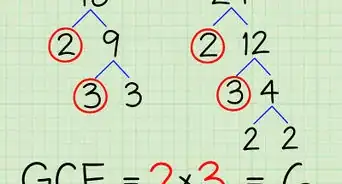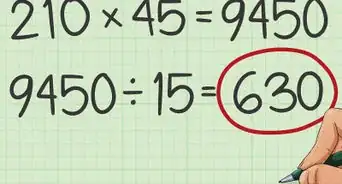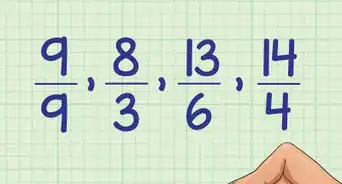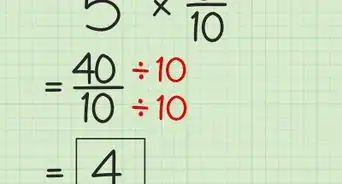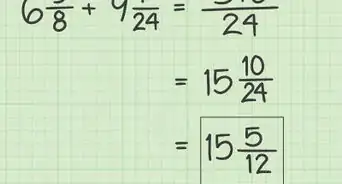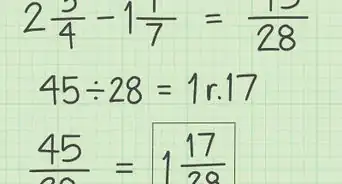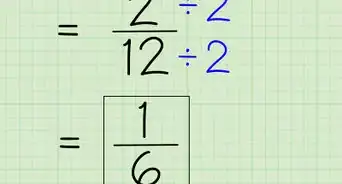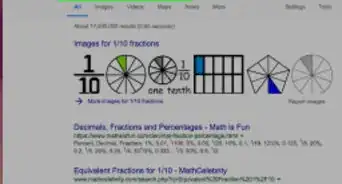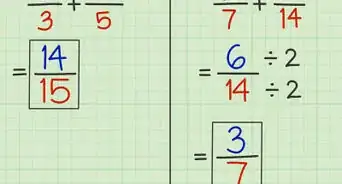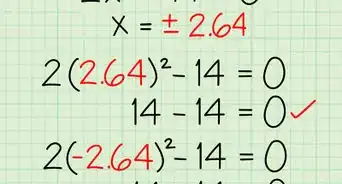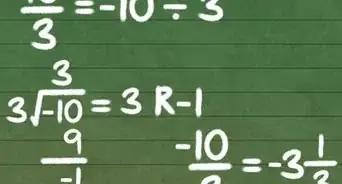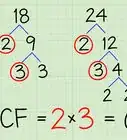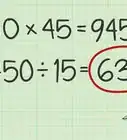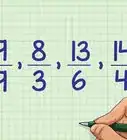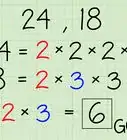This article was co-authored by Mario Banuelos, PhD. Mario Banuelos is an Assistant Professor of Mathematics at California State University, Fresno. With over eight years of teaching experience, Mario specializes in mathematical biology, optimization, statistical models for genome evolution, and data science. Mario holds a BA in Mathematics from California State University, Fresno, and a Ph.D. in Applied Mathematics from the University of California, Merced. Mario has taught at both the high school and collegiate levels.
There are 12 references cited in this article, which can be found at the bottom of the page.
This article has been viewed 657,510 times.
In order to add or subtract fractions with different denominators (the bottom number of the fraction), you must first find a common denominator shared between them. In order to have the simplest fraction at the end, it is best to find not just a common denominator, but the least (or smallest) common denominator. This refers to the lowest multiple shared by each original denominator in the equation, or the smallest whole number that can be divided by each denominator.[1] You may also see the phrase least common multiple. This generally refers to whole numbers, but the methods to find it are the same for both. Determining the least common denominator allows you convert the denominators to the same number so you can then add and subtract them.
Steps
Listing Multiples
-
1List the multiples of each denominator. Make a list of several multiples for each denominator in the equation. Each list should consist of the denominator numeral multiplied by 1, 2, 3, 4, and so on.[2]
- Example: 1/2 + 1/3 + 1/5
- Multiples of 2: 2 * 1 = 2; 2 * 2 = 4; 2 * 3 = 6; 2 * 4 = 8; 2 * 5 = 10; 2 * 6 = 12; 2 * 7 = 14; etc.
- Multiples of 3: 3 * 1 = 3; 3 * 2 = 6; 3 *3 = 9; 3 * 4 = 12; 3 * 5 = 15; 3 * 6 = 18; 3 * 7 = 21; etc.
- Multiples of 5: 5 * 1 = 5; 5 * 2 = 10; 5 * 3 = 15; 5 * 4 = 20; 5 * 5 = 25; 5 * 6 = 30; 5 * 7 = 35; etc.
-
2Identify the lowest common multiple. Scan through each list and mark any multiples that are shared by all of the original denominators. After identifying the common multiples, identify the lowest multiple common to all the denominators.[3]
- Note that if no common multiple exists at this point, you may need to continue writing out multiples until you eventually come across a shared multiple.
- This method is easier to use when small numbers are present in the denominator.
- In this example, the denominators only share one multiple and it is 30: 2 * 15 = 30; 3 * 10 = 30; 5 * 6 = 30
- The LCD = 30
Advertisement -
3Rewrite the original equation. In order to change each fraction in the equation so that it remains true to the original equation, you will need to multiply each numerator (the top of the fraction) and denominator by the same factor used to multiply the corresponding denominator when reaching the LCD.[4]
- Example: (15/15) * (1/2); (10/10) * (1/3); (6/6) * (1/5)
- New equation: 15/30 + 10/30 + 6/30
-
4Solve the rewritten problem. After finding the LCD and changing the fractions accordingly, you should be able to solve the problem without further difficulty. Remember to simplify the fraction at the end.[5]
- Example: 15/30 + 10/30 + 6/30 = 31/30 = 1 1/30
Using the Greatest Common Factor [6]
-
1List all of the factors of each denominator. The factors of a number are all of the whole numbers that are evenly divisible into that number.[7] The number 6 has four factors: 6, 3, 2, and 1. (Every number has a factor of 1, because every number can be evenly divided by 1.)
- For example: 3/8 + 5/12.
- Factors of 8: 1, 2, 4, and 8
- Factors of 12: 1, 2, 3, 4, 6, 12
-
2Identify the greatest common factor between both denominators. Once you have listed the factors of each denominator, circle all of the common factors. The largest of the common factors is the greatest common factor (GCF) that will be used to continue solving the problem.
- In our example, 8 and 12 share the factors 1, 2, and 4.
- The greatest common factor is 4.
-
3Multiply the denominators together. In order to use the greatest common factor to solve the problem, you must first multiply the two denominators together.
- Continuing our example: 8 * 12 = 96
-
4Divide this product by the GCF. After finding the product of the two denominators, divide that product by the GCF you found previously. This number will be your least common denominator (LCD).[8]
- Example: 96 / 4 = 24
-
5Divide the LCD by the original denominator. To determine the multiple needed to make the denominators equal, divide the LCD you determined by the original denominator. Multiply the numerator and the denominator of each fraction by this number. The denominators should now both be equal to the LCD.[9]
- Example: 24 / 8 = 3; 24 / 12 = 2
- (3/3) * (3/8) = 9/24; (2/2) * (5/12) = 10/24
- 9/24 + 10/24
-
6Solve the rewritten equation. With the LCD found, you should be able to add and subtract the fractions in the equation without further difficulty. Remember to simplify the fraction at the end, if possible.
- Example: 9/24 + 10/24 = 19/24
Factoring Each Denominator into Primes
-
1Break each denominator into prime numbers. Factor each denominator digit into a series of prime numbers that multiply together to make that number. Prime numbers are numbers that cannot be divided by any other number.[10]
- Example: 1/4 + 1/5 + 1/12
- Prime factorization of 4: 2 * 2
- Prime factorization of 5: 5
- Prime factorization of 12: 2 * 2 * 3
-
2Count the number of times each prime appears in each factorization. Tally up the number of times that each prime number appears in the factorization of each denominator digit.[11]
- Example: There are two 2’s in 4; zero 2’s in 5; two 2’s in 12
- There are zero 3’s in 4 and 5; one 3 in 12
- There are zero 5’s in 4 and 12; one 5 in 5
-
3Take the largest count for each prime. Identify the largest number of times you used each prime number for any of the denominators and note that count.
- Example: The largest count of 2 is two; the largest of 3 is one; the largest of 5 is one
-
4Write that prime as many times as you counted in the previous step. Do not write out the number of times each prime number appeared throughout all the original denominators. Only write out the largest count, as determined in the previous step.
- Example: 2, 2, 3, 5
-
5Multiply all the prime numbers written in this manner. Multiply the prime numbers together as they appeared in the previous step. The product of these numbers equals the LCD for the original equation.[12]
- Example: 2 * 2 * 3 * 5 = 60
- LCD = 60
-
6Divide the LCD by the original denominator. To determine the multiple needed to make the denominators equal, divide the LCD you determined by the original denominator. Multiply the numerator and the denominator of each fraction by this number. The denominators should now both be equal to the LCD.
- Example: 60/4 = 15; 60/5 = 12; 60/12 = 5
- 15 * (1/4) = 15/60; 12 * (1/5) = 12/60; 5 * (1/12) = 5/60
- 15/60 + 12/60 + 5/60
-
7Solve the rewritten equation. With the LCD found, you should be able to add and subtract the fractions as usual. Remember to simplify the fraction at the end, if possible.
- Example: 15/60 + 12/60 + 5/60 = 32/60 = 8/15
Working with Integers and Mixed Numbers[13]
-
1Convert each integer and mixed number into an improper fraction. Convert mixed numbers into improper fractions by multiplying the integer by the denominator and adding the numerator to the product. Convert integers into improper fractions by placing the integer over a denominator of “1.”
- Example: 8 + 2 1/4 + 2/3
- 8 = 8/1
- 2 1/4; 2 * 4 + 1 = 8 + 1 = 9; 9/4
- Rewritten equation: 8/1 + 9/4 + 2/3
-
2Find the least common denominator. Implement any of the methods used for finding the LCD of common fractions, as explained in the previous method sections. Note that for this example, we will be using the “listing multiples” method, in which a list of multiples is created for each denominator and the LCD is identified from these lists.[14]
- Note that you do not need to create a list of multiples for 1 since any number multiplied by 1 equals itself; in other words, every number is a multiple of 1.
- Example: 4 * 1 = 4; 4 * 2 = 8; 4 * 3 = 12; 4 * 4 = 16; etc.
- 3 * 1 = 3; 3 * 2 = 6; 3 * 3 = 9; 3 * 4 = 12; etc.
- The LCD = 12
-
3Rewrite the original equation. Instead of multiplying the denominator alone, you must multiply the entire fraction by the digit required for changing the original denominator into the LCD.
- Example: (12/12) * (8/1) = 96/12; (3/3) * (9/4) = 27/12; (4/4) * (2/3) = 8/12
- 96/12 + 27/12 + 8/12
-
4Solve the equation. With the LCD determined and the original equation changed to reflect the LCD, you should be able to add and subtract without difficulty. Remember to simplify the fraction at the end, if possible.[15]
- Example: 96/12 + 27/12 + 8/12 = 131/12 = 10 11/12
Practice Problems and Answers
Expert Q&A
Did you know you can get expert answers for this article?
Unlock expert answers by supporting wikiHow
-
QuestionHow do you find the LCD of two fractions?
 Mario Banuelos, PhDMario Banuelos is an Assistant Professor of Mathematics at California State University, Fresno. With over eight years of teaching experience, Mario specializes in mathematical biology, optimization, statistical models for genome evolution, and data science. Mario holds a BA in Mathematics from California State University, Fresno, and a Ph.D. in Applied Mathematics from the University of California, Merced. Mario has taught at both the high school and collegiate levels.
Mario Banuelos, PhDMario Banuelos is an Assistant Professor of Mathematics at California State University, Fresno. With over eight years of teaching experience, Mario specializes in mathematical biology, optimization, statistical models for genome evolution, and data science. Mario holds a BA in Mathematics from California State University, Fresno, and a Ph.D. in Applied Mathematics from the University of California, Merced. Mario has taught at both the high school and collegiate levels.
Assistant Professor of Mathematics One way to do this is to write out all of the multiples of both denominators, then see where they match for the first time. You can also factor both the denominators and see if there are any common factors. If they do share common factors, the ones they do not have in common will give you insight into how to get the least common denominator.
One way to do this is to write out all of the multiples of both denominators, then see where they match for the first time. You can also factor both the denominators and see if there are any common factors. If they do share common factors, the ones they do not have in common will give you insight into how to get the least common denominator. -
QuestionWhat is the LCD of 1/4 and 3/8?
 Community AnswerFirst, you must see what lowest number that both 4 and 8 will go into evenly. Since four can go evenly into 8, and 8 goes into itself evenly, then LCD of these two fractions is 8.
Community AnswerFirst, you must see what lowest number that both 4 and 8 will go into evenly. Since four can go evenly into 8, and 8 goes into itself evenly, then LCD of these two fractions is 8. -
QuestionHow do I subtract 4/5 from 8/10?
 DonaganTop AnswererExpress both fractions with the same denominator. 4/5 is the equivalent of 8/10. 8/10 - 8/10 equals zero.
DonaganTop AnswererExpress both fractions with the same denominator. 4/5 is the equivalent of 8/10. 8/10 - 8/10 equals zero.
Things You'll Need
- Pencil
- Paper
- Calculator (optional)
References
- ↑ https://www.mathsisfun.com/definitions/least-common-denominator.html
- ↑ Mario Banuelos, PhD. Assistant Professor of Mathematics. Expert Interview. 11 December 2021.
- ↑ Mario Banuelos, PhD. Assistant Professor of Mathematics. Expert Interview. 11 December 2021.
- ↑ https://www.mathsisfun.com/least-common-denominator.html
- ↑ https://www.mathsisfun.com/least-common-denominator.html
- ↑ http://www.aaamath.com/fra66jx2.htm
- ↑ https://www.mathsisfun.com/greatest-common-factor.html
- ↑ https://www.calculatorsoup.com/calculators/math/lcm.php
- ↑ https://www.calculator.net/lcm-calculator.html
- ↑ https://www.mathsisfun.com/prime_numbers.html
- ↑ https://math.libretexts.org/Bookshelves/PreAlgebra/Book%3A_Prealgebra_(OpenStax)/02%3A_Introduction_to_the_Language_of_Algebra/2.10%3A_Prime_Factorization_and_the_Least_Common_Multiple_(Part_2)
- ↑ https://math.libretexts.org/Bookshelves/PreAlgebra/Book%3A_Prealgebra_(OpenStax)/02%3A_Introduction_to_the_Language_of_Algebra/2.10%3A_Prime_Factorization_and_the_Least_Common_Multiple_(Part_2)
- ↑ http://www.calculatorsoup.com/calculators/math/lcd.php#.Ua0eFkDryj4
- ↑ https://www.calculatorsoup.com/calculators/math/lcd.php
- ↑ https://www.georgebrown.ca/sites/default/files/uploadedfiles/tlc/_documents/Adding_and_Subtracting_Mixed_Numbers_and_Improper_Fractions.pdf
About This Article
One way to find the least common denominator (LCD) of two or more fractions is by listing the factors of each denominator, which are all of the whole numbers that divide evenly into that number. Then, identify the greatest common factor between the two denominators. To use this number to find the LCD, multiply the two denominators together and divide that number by the greatest common factor. For example, for ⅜ and 5/12, the greatest common factor is 4, and the two denominators multiplied are 96. 96 divided by four is 24, which is the LCD. If you want to learn how to find the LCD using prime numbers, keep reading the article!


